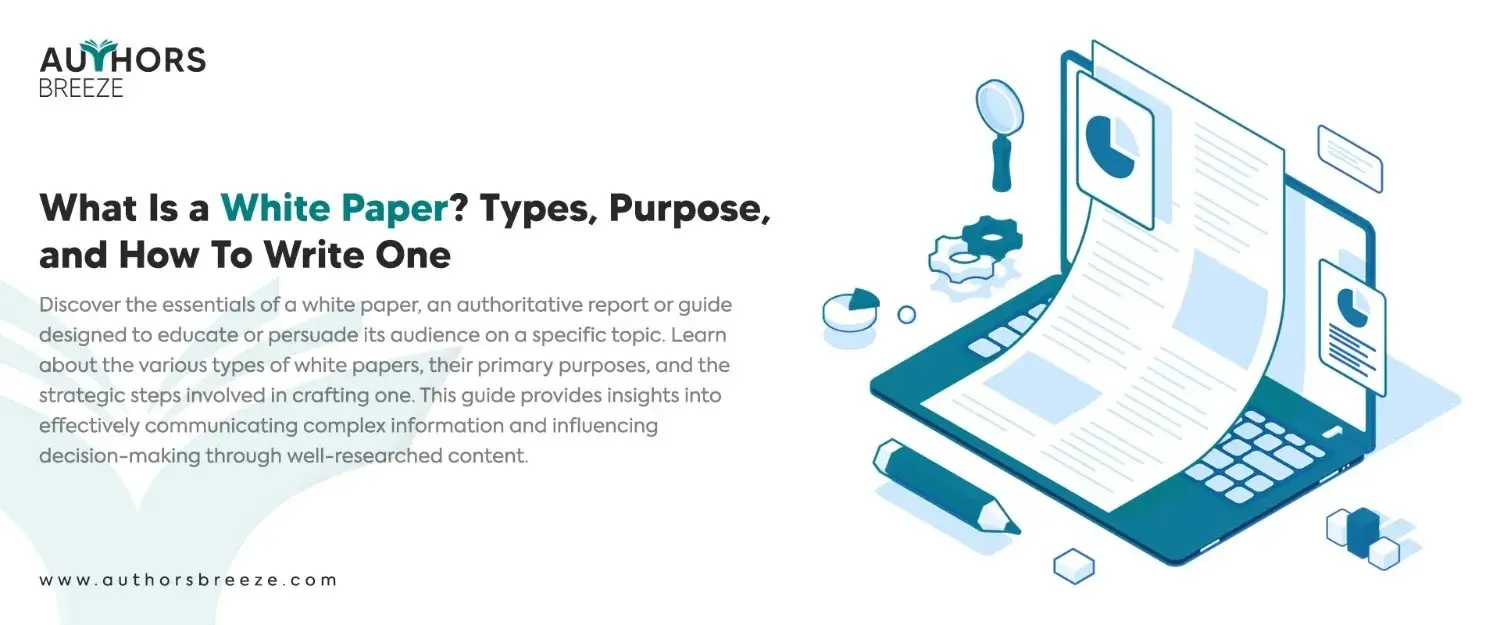Don’t Have Time to Read? Listen to this White Paper Instead!
Key Takeaways – What is a White Paper?
- A white paper is a guide that explains complex topics simply and easily.
- It helps the audience understand issues, presents viewpoints, and suggests solutions.
- White papers are detailed and severe documents focusing on educating rather than selling.
- There are three types: Backgrounder, Problem/Solution, and Numbered List.
- The white paper involves researching, understanding the audience, outlining, writing clearly, and reviewing.
Take Your White Paper Skills to the Next Level
Learn valuable tips and strategies to improve your white paper writing. Authors Breeze provides a helping hand to make your writing shine.
Introduction
If you are part of a company, business, or non-profit organization, then you must have come across “white paper.” However, what exactly is a white paper? Why are they so important? We will explain everything in great detail. So, get along with us and explore with us everything that has to do with white papers.
What is a White Paper?
A white paper is a detailed guide. It is a type of content writing that helps explain complicated topics in a transparent way. It is written to help people:
- Understand an issue
- Show them the writer’s point of view
- Suggest solutions
White Paper Definition
A white paper is an explanatory report that explains complex or technical topics clearly and in detail.
For example:
Imagine you have an incredible book to sell, but it’s not enough to just put it on a shelf and hope to get book sales without any effort. It would be best if you had a way to make people see why this book is unique and how it can benefit them. To do this, you create a detailed guide that explains everything about the books, such as book cover design, unique points, and how it can solve a problem or meet a need for readers.
That’s what a white paper does. Just like this detailed guide for your book, a white paper is a comprehensive document written by experts to provide in-depth information on a specific issue or topic. It helps people understand the complexities of the subject and often persuades them why a particular solution or product (like your book) is the best choice.
Here’s a simple breakdown of what makes up a white paper:
A teacher of complex topics
Suppose there is a tricky subject that people need to understand. In that case, a white paper comes into action. It explains the subject in simple terms and offers new information or solutions.
Helps you make decisions
It offers facts and expert opinions. A white paper can help you make crucial decisions, especially if you have to buy something or support a particular viewpoint.
Serious and smart
White papers are formal. This means that they are not casual chats. Their tone is serious and is based on important issues. They are intelligent and filled with research and facts to back up what is said.
Not a sales pitch, but it can persuade
A white paper might help a company show off its products. However, it is not just trying to sell you something. It is more about teaching you why an idea or solution is good. Its purpose is to let you decide for yourself.
What are the Types of White Paper?
White papers are reports that share detailed information on specific topics. They are guides that help people in different ways. They help with:
- Understanding complex subjects
- Make decisions
- Solve problems
- Generates leads
While they may sound severe, they can be written in easier words as well. So, what are its types? There are three types of white papers, namely:
- Backgrounder
- Problem/Solution
- Numbered List
Backgrounder
To understand this, imagine your favorite new video game console or the latest smartphone. A backgrounder white paper will tell you all about the console to you, including:
- Its features
- How it works
- Why it is awesome
It is as if you are diving deep into a product. It helps those people who are thinking about buying it or just want to know more.
Problem/Solution
As the name suggests, it revolves around a specific problem and explains its best solution. In easy words, think of a common situation. For instance, how to save money or get better at a video game. A problem/solution white paper explains the problem in simple terms. Then, it suggests a way to fix it. It often uses a specific product or service as a solution. It is just like having a friend—a friend who first understands your problem and then advises you on how to solve it.
Numbered List
Last but not least, there is another type of white paper, the numbered list. Unlike the other two, it is more fun. It is like a countdown. For example:
“10 ways to improve your photography” or “5 steps to become a better writer.” It breaks down information into a step-by-step process that is easy to read and understand. Each point in the list is explained with details and examples.
Why Use Different Types?
For Different Readers
You can use it for different readers or audiences. Some people may want to buy something and enjoy all the technical details (Backgrounder). Others may have a problem that they are trying to solve (Problem/Solution). Lastly, there can be people who have an interest in that specific topic (Numbered List).
For Different Situations
A backgrounder is an excellent option if a company is launching a new product. The company can show off its features through it. They can also use problem/solution white paper to show how their product can solve an issue. In addition, if they want to catch someone’s interest, then a numbered list works well.
To Make Things Clear
White papers help break down big, complicated ideas into bits that are easier to understand. A white paper is beneficial if you want to:
- Explain how something works
- Solve a problem
- Share cool ideas
What is the Purpose of White Papers?
White papers are like exceptional guides that have a bunch of different uses. It depends on what you need them for. Let’s break down the main reasons professionals create and use white papers:
To Teach and Explain
Sometimes, things can be really complicated to understand, such as:
- How the internet works?
- What is blockchain?
- How to operate a device?
White papers are best if you want to break down these big ideas into smaller, easier-to-understand pieces. They give you all the details you need to understand what is going on without getting confused.
To Share Solutions
One of the primary purposes for which it is used or can be used is problem-solving. Suppose someone has a problem, such as a phone always running out of battery quickly. Then, a white paper can show why this happens and suggest ways to fix it. It often includes making a product or service as a base of the solution. In this case, it may mean buying a battery from their brand.
To Convince You
Sometimes, companies have new products that they want you to try. They use white papers to tell you all about the product. It may include why it is impressive and how it can make your life better. They are not just trying to sell you something. They are trying to show you how it solves a problem or fulfills a need you have.
To Help Make Decisions
When it is time to make big decisions, such as:
- Which computer to buy
- What smartphone is better
- Which service to use
White papers can be super helpful for all of such decisions. They offer you everything, which includes:
- All the facts
- Pros and cons
- Comparison of different options
This can help you make better decisions and opt for the product that is best for you.
To Start Conversations
White papers are not just for serious matters. You can get creative with them, too. You can get people talking about:
- New ideas
- Trends
- Issues
When you share new research or viewpoints, they can spark discussions. It can be among experts in a field or just friends interested in a topic.
Why write a white paper?
Think of a white paper as a way to show off how much you or your company knows about a specific topic. The goal is to convince people that your way of solving the problem is the best one by sharing facts and logic. You are not directly saying “buy our product” or “use our service.” However, you are just showing how knowledgeable you are, which can make people think highly of you or your company.
Who is it for?
White papers are for people who are not experts in your field but want to learn more about it. These readers might know a little bit about the topic. Or they may be looking for information to help them decide before they buy something or pick a service in the future. So, a white paper is your chance to help them out. You can share your expert knowledge and advice, all based on solid research and good arguments.
How To Write A White Paper
Writing and publishing white papers may sound like a big deal. However, it is just about sharing knowledge or solutions in a helpful and convincing way. You can use it to explain:
- How a gadget works.
- Solve a common issue.
- Showing why your idea is the best.
The main goal is to be
- Clear
- Informative
- Persuasive
Here is a simple guide on how to write them:
Step 1. Choose Your Topic
First, figure out what you want to talk about. Make sure that it is something you know a lot about or a problem you have a good solution for. Research about what your readers might be interested in or what they need help with. You have to pick the perfect solution or option for your audience. Therefore, choose something that is helpful for them.
Step 2. Do Your Research
Next, gather all the info you need. This can include
- Facts
- Reports
- Experts opinions
You have to know your topic inside and out. So you can explain it well and answer any questions your readers might have. Therefore, take all your time and gather the best information to present to your readers.
Step 3. Know Your Audience
A significant part of writing a white paper is that you have to know about your audience. Think of those who will read your white paper and ask questions such as:
- What do they already know?
- What do they need to learn?
Understanding your audience helps you decide how to explain things to them and what kind of information to include.
Step 4. Outline Your Paper
Before you start to write, plan out what you want to add. Make a list of the main points you want to cover. In addition, make an outline of the order in which you would like to present them. This helps keep your writing organized and ensures that you do not miss anything important.
Step 5. Write Clearly and Concisely
Now, for the central part of the process, how do you write a white paper? For this, you have to keep your language simple and to the point. You want to explain your ideas clearly so anyone can understand them. It should be so clear that they can understand it even if they are not an expert on the topic. Also, you can use examples to help make your points.
Step 6. Provide Solutions or Insights
Always keep in mind that the goal of a white paper is to help your readers in some way. Make sure you clearly explain how your products or services solve a problem or help them in some way or another.
Step 7. Editing
Editing is vital for ensuring clarity and coherence. You should check for grammatical errors and typos. Ensure that the information flows logically and all points are clearly explained. This comprehensive editing process will enhance the quality and impact of your white paper.
Step 8. Review and Revise
After you write it, take some time for proofreading. It will help you make any changes you think are necessary. It is always good to have someone else read it, too, for a fresh and different perspective. They may identify mistakes that you missed or have suggestions for making it even better. This way, you can improve your white paper even more.
Step 9. Publishing
Once your white paper is written and edited, consider the best way to publish it. You can self-publish it on your company’s website or in an ebook format. Further, share it through social media channels and send it to your email subscribers. Last but not least, try to submit it to relevant industry publications or blogs. Make sure to format the white paper professionally. Also, white paper includes visuals such as graphs, charts, and images to make it more engaging.
Make White Paper Error-Free
Focus on your writing. We’ll handle the proofreading. Our team ensures your white paper is flawless.
Frequently Asked Question
What is the difference between a white paper and a report?
A report just lays out the facts and findings only. On the other hand, white paper goes the extra mile to catch the reader's interest and convince them about a particular idea. It is also a marketing tool for companies to add excitement about what they have to offer.
What was the purpose of the white paper?
White papers are detailed guides that dive deep into a complicated topic to explain it from the writer's perspective. They aim to educate readers on an issue and help them understand it better. This allows them to make informed choices or solve specific problems.
What is a whitepaper in business?
A white paper in business is a detailed document that a company puts out to lay down the benefits of their:
- Product
- Solution
- Service
It is not just about selling. White papers can also explain government policies or seek public feedback on proposed laws.
Conclusion
So, to conclude this, white papers are essential guides that help explain complicated topics in an easy way. They help businesses and groups:
- Share what they know
- Convince others with facts
- Offer solutions to problems.
It is vital for you to write everything clearly. It does not matter if it is:
- About a new gadget
- A way to fix an issue
- Sharing information
Therefore, if you plan to write a white paper, pick a topic you know well. Do your homework and keep it simple. Finally, focus on how you can help your readers. To further understand it, you can look at some examples of a white paper, or you can also consult Authors Breeze. They can help you understand it and even write it for you.
We Create White Papers that Converts Leads
Are you looking to boost brand recognition or qualified leads? Our content writers craft compelling white papers that achieve your goals.






